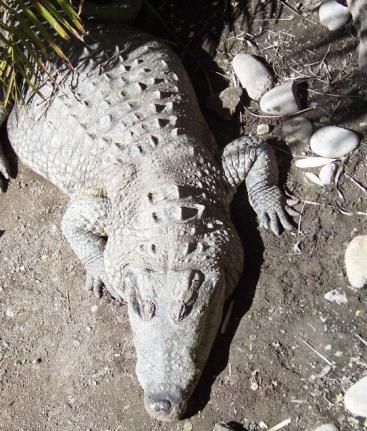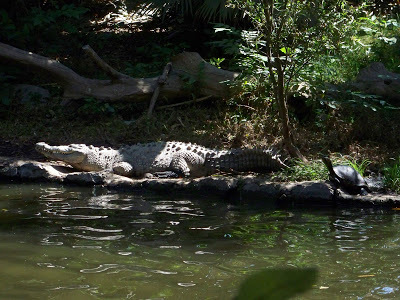A Keeper's Tale, Part 3 of 5: Crocodiles and Caimans

by guest writer Hodari Nundu
I should probably say a few things about crocodiles in Mexico.We have four species of crocodilians. One of them is most familiar forAmericans-- the American alligator. Officially, gators have been extinct inMexico since the nineteenth century. However, a few of them are seen and evenphotographed every now and then in the country's northernmost rivers and lakes.
In the southern states of Oaxaca and Chiapas lives a morecommon, but still seldom encountered relative to the alligator. It is thespectacled caiman, which can grow up to three meters long and is notoriouslyable to change color- although its ability to do so is very limited compared tothat of say, a chameleon.
Caimans are usually considered to be harmless to peopleunder normal circumstances; they rarely grow large enough to devour an adulthuman. However, they have quick reflexes and their teeth are sharper than acrocodile's; they are, as all wild predators, better left alone.
In the southeastern states lives the Mexican crocodile, alsoknown as Morelet's crocodile. Once on the verge of extinction due to hunting,it is now a protected species, and its population is on the rise. Recently, aswimmer was attacked by one near a popular touristic destination. However, mostattacks by these crocs are territorial, or triggered by a female's maternal instinct.Indeed, Morelet's crocs are ferociously protective of their nests and young.
I learned this during a trip to a crocodile breeding centerin Colima. The area was natural American croc habitat; there was a lake whereyou could see the larger crocodiles -- the males -- patrolling for potentialintruders.
There were also Morelet's crocodiles, but since they weren´tnative to the area, they were kept in enclosures to keep them apart.
I noticed that one of the female Morelet's had a nest, and gotan idea for a little experiment. You see, one of my secret talents is mimickinganimal calls. I am particularly proud of my American alligator mating call --which I certainly do not intend to use in gator country. Although some peoplehave praised my mockingbird-like talents, truth is I appreciate critiques byanimals even more. I took it as a compliment when I managed to frighten thezoo's chital deer by mimicking their tiger alarm, or when I caused a maleleopard to go ballistic after mimicking the big cat's territorial call. Becausethe leopard had seemed ready to leap out of its enclosure that time, I hadpromised myself to stop mimicking animal calls in front of the real things.
But that day in the crocodile breeding center I simplycouldn´t resist. Seeing that the mother crocodile was basking besides its nest,I started imitating the chirping call of a baby crocodile.
The female's reaction was explosive. I don´t know what wentthrough her mind; maybe that her babies were about to be born, and that thehuman standing beside her enclosure had to be frightened away immediately. Ormaybe she assumed that I had abducted one of her babies, seeing as the soundcame from outside the enclosure. I also considered the possibility that shemight have recognized my call as a fake, and was angered at my vocalincompetence to the point of charging the fence, slamming her heavy armoredhead against it and letting out a veryloud warning hiss.
I didn´t bother her further after that. I was lucky therewas a fence between her jaws and me!
The fourth and largest crocodile species in Mexico is theAmerican crocodile. In Spanish, it is often called the "cocodrilo de río",meaning "river crocodile", whereas the Morelet's crocodile is called "cocodrilode pantano", "swamp crocodile". However, these names can lead to confusion asboth species can be found in either rivers or swamps. In fact, the Americancrocodile is not very picky about where it lives. It has been seen even in the sea,and recently a man was attacked by one while repairing his yatch in the Pacificcoast. This is why it is also known as the "American saltwater crocodile".

When Steve Irwin visited Mexico, he expressed his surpriseat the docility of American crocodiles. But although they may seem mellow whencompared to their infamous Australian relatives, American crocs are not to beunderestimated. In the US, where crocodiles are extremely rare, attacks onhumans were unknown until very recently. In Mexico, it is a very differentstory. American crocodiles are numerous and widespread -- protected by the law,they have recovered after decades of ruthless extermination. Attacks on humans,many of them fatal, have been recorded along both coasts of the country.Usually the victims are drunken men who ignore warning signs and go for a swimin crocodile-infested rivers. Sometimes, it is playing children who getsnatched. Livestock, including horses and cattle, are also taken.
American crocodiles are responsible for most predatoryattacks on humans in the country. Compared to them, American black bears,jaguars and cougars seem rather shy.
Although the eight-meter long individuals reported by afamous zoologist from Chiapas seem to be a thing of the past, large malesmeasuring over five meters are still found regularly. The same breeding centerwhere I provoked the female Morelet's used to be home to a six and a half-meterlong American crocodile, said by the gamekeepers to be possibly over a hundredyears old.
Unfortunately, this giant was murdered when it wandered awayfrom the lake and into the woods, where it was found by hunters.
The breeding center kept the giant crocodile's skull as areminder of the huge size attained by these reptiles, provided they are giventhe opportunity to grow up in peace.
It was this largest, most aggressive species we'd be workingwith at the park. But before we were allowed into the croc enclosure, we had tostart with other, less dangerous reptiles.
Top photo: Morelet's Crocodile/Hodari NunduBottom photo: American Crocodile/Hodari Nundu
Next: Part 4: Hot Herps
Published on November 24, 2011 09:00
No comments have been added yet.



